- Home
- About
- Artist Statement
- Artist Resume
- History of Kinetic Fine Art
- future gallery
- Artist Portfolio
- New Artwork
Kinetic Fine Art:
finest selection in
kinetic paintings
Phone: 505-927-7052
kinetic_art@moiretomas.com

side view of front projection and rear projection behind wall
of one type of kinetic painting
Web Development by
Moire Tomas, Ed.D
Artist Statement
I have been a kinetic painter for well over forty years. There are three major types of motion that can be assimilated into a kinetic painting: (1) actual motion, (2) spectator motion, and (3)implied motion. My work has transformed through these different types of motion.
In the 1960's, I could see many screen paintings on windows and doors in the Canton and Fells Point areas in Maryland. I was very much influenced by this way of dispalying art.
So I started painting window screens in the late 1960's and early 1970's.. This is an example of this period.

In the early 1970's, I also experimented with my first kinetic paintings. I used multi-layered screens in my kinetic paintings. The motion in the painting is actually created by the spectator. As the viewer moves from side to side viewing the picture, motion is created by way of overlapping screens as moving moire paterns created by the assimilated effect of overlapping screens and spectator motion. Below are two examples.


I also created screen paintings, pencil drawings, and canvas paintings using acrylics during this period. However, these mentioned examples were not kinetic paintings. Here are but a few examples.







Later in the 1970's, I used the reflective properties of plastics. The motion in this example was also created by the motion of the spectator and the reflective properties of the plastics.

In the early 1990's, I started experimenting with actual motion. These paintings have actual motion using motors. This is similar to spectator motion, but now the motion is created by a physical (mechanical) means. You can't see the motor or the large wheel behind the painting. What you do see is an array of moving patterns going through the painting. This created the realistic effect of the water flowing, and many other effects as well. Here are two examples of this period.


In 1995, I met Ulrich Niemeyer, Director of Design Foundation (now Visual Communication) at Northern New Mexico Community College. He was starting a new program for artist using the computer. I was hooked. In 1998, a local newspaper noticed my moire animations and published my work in the Rio Grande Sun. Then I met Dr. Drake Bingham, Director of Mass Communication at New Mexico Highlands University. He allowed me to develop the art form for my graduate work. For the first time, I was able to incorporate my early knowledge with kinetic painting with the computer.
During this time-period in 1999, I coined the term Kinetic Fine Art. In 2003, I began using this trade name to sell my kinetic paintings and wrote a dissertation on the History of Kinetic Fine Art to explain the importance of the kinetic painting.
As well, in 2003 for my graduate work, I completed my first high-tech Kinetic painting, a kinetic painting using window screens with an acrylic painting and a computer controlled plasmatron monitor. The video-animation, playing in the plasmatron monitor, is seen through a pair of window screen paintings. The monitor and the two screen paintings are all enclosed within a frame. This constitutes the 4D kinetic painting because space and time are introduced through the animation. The combination of window screen paintings and computer controlled video-animation is the culmination of decades of growth as a kinetic painter. Here is a still photo example.
Also during this same period, I started experimenting with computer controlled rear-projection system combined with front-projection. I used the rear-projection systems at Northern New Mexico Community College to display an animation through my two-layered kinetic screen paintings. As well, front projection was used for additional effects. This was a fairly large kinetic painting (54 x 72 inches approximate size). This was also duly noted by the local newspaper "Rio Grande Sun" in 2003. In 2008, I enrolled in a doctoral program and completed it in 2012. I recieved a Doctor of Education and started a nonprofit called Academic Social Innovation in 2013 to help academically underprepared adults obtain their educational and employment goals.
Moire Buffalo_Plasma, 2003
Dimensions: 28 x 43 x 7.5
Then in 2005, I participated in developing a group artist’s show at the RampArt Gallery in Tacoma, Washington. In 2006, we had the group show opening at the Gallery called "Renaissance". These kinetic paintings were dual-layer screens paintings that relied on spectator motion. However, there was one picture in the show that incorporated a computer-controlled animation into the kinetic painting.
Here are examples from that show.

Singularity of Defraction, 2005
Dimensions: 28 x 43 x 7.5

Moire Woman, 2005
Dimensions: 28 x 43 x 7.5

Quantum Landscape, 2005
Dimensions: 28 x 43 x 7.5
In 2014, I was in a one-person art show for the entire month of July at the Friendship Club located at 1915 Rosina Street, Santa Fe NM 87505. The pictures in this show are a combination of pencil, ink, and acrylics assimilated into each picture. The motion is an implied motion from the particle-wave patterns depicted within the art work.
Here are some examples for the previously mentioned one-person art show named God Particle Series.

Created in 2014

Also created in 2014



